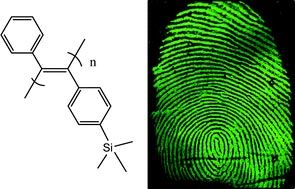Fluorescent fingerprints
Latent fingerprints at the scene of a crime can give vital clues in a criminal investigation. Giseop Kwak and colleagues from Kyungpook National University, in Korea, have successfully developed a technique to detect fingerprints in a convenient and non-destructive manner.

Kwak and colleagues use a highly fluorescent conjugated polymer film to detect fingerprints. All latent fingerprints contain oil residues, made up of triglycerides, wax esters and squalene, which are deposited when the fingerprint was made. On contact with the fluorescent polymer film, these residues diffuse into microvoids throughout the film resulting in film swelling and an increase in fluorescence intensity. High resolution images with clear ridges and valleys are obtained using this technique, which could help aid officers investigating crime scenes.
Significantly, the fluorescent conjugated polymer film is responsive to even slight amounts of oil residues, and therefore will be effective in spite of individual variations of quantity.
‘We expect the present polymer film to be a useful material for convenient, non-destructive fingerprint detection and highly reliable evidence accumulation in criminal investigations,’ says Kwak.
Original article: Kwak et. al.; "Fluorescence imaging of latent fingerprints on conjugated polymer films with large fractional free volume"; Chem. Commun. 2009
Organizations
Other news from the department science

Get the analytics and lab tech industry in your inbox
By submitting this form you agree that LUMITOS AG will send you the newsletter(s) selected above by email. Your data will not be passed on to third parties. Your data will be stored and processed in accordance with our data protection regulations. LUMITOS may contact you by email for the purpose of advertising or market and opinion surveys. You can revoke your consent at any time without giving reasons to LUMITOS AG, Ernst-Augustin-Str. 2, 12489 Berlin, Germany or by e-mail at revoke@lumitos.com with effect for the future. In addition, each email contains a link to unsubscribe from the corresponding newsletter.























































